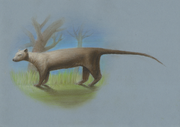| ||||||||||||
The antamba was a cryptid reported from Madagascar, allegedly a large cat-like predator.[2] In his work Histoire de la Grande Isle de Madagascar (1658), the French Governor of Madagascar Admiral Étienne de Flacourt (1607 – 1660) recorded "scrupulously accurate"[3] descriptions of a number of Malagasy animals, including three now often identified with subfossil species; the tratratratra, vorompatra, and antamba.[1]
| “ | The Madagascar antamba is an animal as large as a dog, with a round head, and, according to the relations of the Negroes, resembling the leopard. It devours both men and cattle, and is only found in the most desert[ed] parts of the island.
|
” |
Unlike the vorompatra and tratratratra, the antamba continued to be reported long after Flacourt's time. In 1883, Malagasy folklore compiler James Sibree found it "difficult to say whether the antamba is a mythical creature, or has any real existence," although he felt that it was very like the fossa (Cryptoprocta ferox).[4] During the 1930s, French hunter Paul Cazard received reports of giant cave-dwelling lions existing in remote parts of the island, where they killed both livestock and people;[5] Dale A. Drinnon associated these stories with the antamba, but Markus Bühler contests this, considering Malagasy cats to be typical alien big cats.[6] At the end of the 20th Century, fossa specialist Luke Dollar heard persistent rumours of the antamba, prompting him to lead an unsuccessful expedition to Zahamena National Park in search of it in November 1999.[2][7]

The antamba is frequently identified with the subfossil giant fossa (Cryptoprocta spelea; CC BY-SA 3.0).
Despite the belief of some early zoologists that the antamba was a genuine leopard, cryptozoologists and a handful of mainstream zoologists identify it with the "puma-like" giant fossa (Cryptoprocta spelea), a species of controversial taxonomy, known from subfossil remains dated to the Holocene. Aside from Dollar, some fossa workers remain open to the possibility that a second species of fossa still exists in Madagascar.[8] In 1954, an M. Louvel reported that a forestry official had captured a very large fossa raiding a chicken coop in the forest of Morondava, on the west coast of Madagascar. This official claimed that the specimen had measured 2 m (7 ft) in length and 30 kg (70 lb) in weight, significantly heavier than an ordinary individual.[9] It has long been known that Malagasy peoples across the island recognise two different varieties of fossa: the fosa mena ("reddish fossa") and the fosa mainty ("black fossa"), which is larger and rarer than the ordinary red species, although it is unclear if the difference is truly taxonomic, and not merely based on age, gender, or regional variation.[10][8]
Notes and references[]
- ↑ 1.0 1.1 Flacourt, Étienne de (1658) Histoire de la Grande Isle de Madagascar
- ↑ 2.0 2.1 Shuker, Karl P. N. (2013) Mirabilis: A Carnival of Cryptozoology and Unnatural History, Anomalist Books, ISBN 978-1-938398-05-6
- ↑ Richard-Vindard, G. & Battistini, R. (2013) Biogeography and Ecology in Madagascar
- ↑ Sibree, James "The Oratory, Songs, Legends, and Folk-Tales of the Malagasy," The Folk-Lore Journal, Vol. 1, No. 10 (October 1883)
- ↑ Eberhart, George M. (2002) Mysterious Creatures: A Guide to Cryptozoology, ABC-CLIO, Inc., ISBN 1576072835
- ↑ Drinnon, Dale A. (16 July 2013) "Persisting Giant Lemurs of Madagascar" frontiersofzoology.blogspot.com [Accessed 29 April 2020]
- ↑ Croke, Vicki & Roft, Roy "The Deadliest Carnivore," Discover Magazine (1 April 2000)
- ↑ 8.0 8.1 Goodman, Steven M. "On the Specific Identification of Subfossil Cryptoprocta (Mammalia, Carnivora) from Madagascar," Zoosystema, Vol. 26, No. 1 (2004)
- ↑ Louvel, M. "Quelques Observations sur le Fosa," Bulletin de l'Académie Malgache, No. 31 (1954)
- ↑ Goodman, Steven M. (2003) The Natural History of Madagascar
